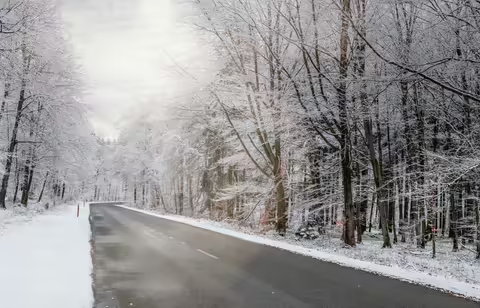URBANA, Ill. – Deicing salts are essential to winter travel in Illinois and provide necessary safety in a landscape setting by melting dangerous ice on precarious steps, sidewalks, entryways and other areas of frequent foot traffic. However, damage from salt can be a major problem in some landscapes by negatively impacting plant health or sometimes outright killing plants from overexposure.
"Rock salt, or sodium chloride, is the most commonly used deicing agent," says Ryan Pankau, University of Illinois Extension horticulture educator. "It is relatively inexpensive, very effective, and widely available."
There are some drawbacks; it's highly corrosive to vehicles and concrete and it's mobile in the environment, which can ultimately end up impacting plant life in several ways.
Salts typically move in the environment, either as runoff in meltwater or as aerosol sprays dispersed by fast moving vehicles and wind. The greatest plant damage from salt usually occurs around major roadways as sprays accumulate on plant parts.
"Evergreen foliage is most at risk of damage from wafting sprays, which can sometimes move as far as several hundred feet from highways and other high speed thoroughfares; however, spray damage can occur along smaller roads and pathways, even sidewalks," Pankau says.
Plants showing damage from salt spray are easily identified since damage is concentrated on the road side of plants. In addition, the suspended spray often only reaches a specific height on affected plants, creating a distinct line where damaged foliage ends.
A less common, but often more serous, plant aliment can occur if salt-laden meltwater infiltrates the soil profile. In these cases, soil very near a source of salt, such as a heavily treated sidewalk or similar surface, accumulates sodium. The impact is often very concentrated in well defined drainage paths, Pankau says.
"As sodium accumulates in the soil profile, it can have dramatic effects on soil properties over time, from raising pH to destroying soil structure that ultimately results in additional soil compaction," Pankau says.
At times, it can create soil conditions unsuitable for root growth, but can also be detrimental to beneficial soil biota, such as mycorrhizae. In addition, salts in soils actually absorb soil water that would otherwise be available to the plants.
Since salt application is often essential for safety in the built environment, what are some ways we can limit the impact to plants? Pankau suggests moderate use of salt, when possible.
"I am always quick to shovel new fallen snow since removal is much easier when it’s light and fluffy, as opposed to after the kids have tromped it into the sidewalk," Pankau says. "Save the salt for the tiny patches of ice left after shoveling, and when you do apply it, apply a small amount and wait."
Pre-application with a liquid form of deicer is considerably more efficient. Many states are reporting dramatic decreases in road salt use as highway departments turn to liquid application and pre-treatment. At the homeowner scale, some hot water and a small pressurized sprayer can be used to dissolve the salt and very efficiently apply it. The direction and rate of application can sometimes help to limit plant exposure, if strategically applied, Pankau says.
Be aware that salt is very corrosive to sprayer parts, so careful cleaning and rinsing after use can help prolong the sprayer life.
Alternatives to the traditional rock salt include calcium chloride which can melt ice at temperatures down to about -60°F. At high levels it can damage plants, but it is significantly less harmful to soils, Pankau says. Calcium magnesium acetate is another alternative that is biodegradable and causes no harm to plants and soil.
SOURCE: Ryan Pankau, Illinois Extension, Horticulture Educator
ABOUT EXTENSION: Illinois Extension leads public outreach for University of Illinois by translating research into action plans that allow Illinois families, businesses, and community leaders to solve problems, make informed decisions, and adapt to changes and opportunities.
